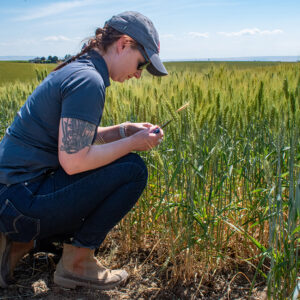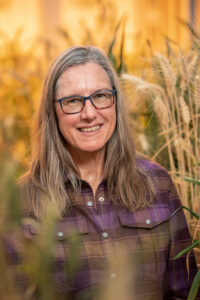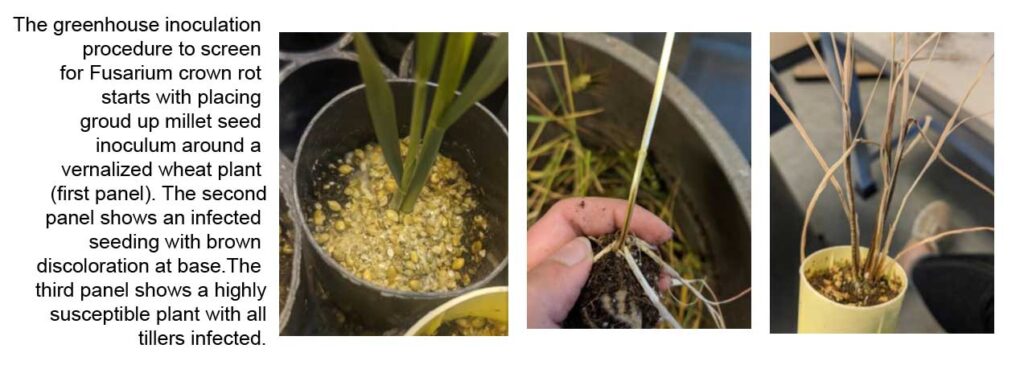Genetic resistance, tolerance will be best management tools
By Timothy C. Paulitz and Kimberly Garland-Campbell
Of all the soilborne fungal pathogens that attack wheat in the dryland Pacific Northwest (PNW), Fusarium crown rot is the most ubiquitous and widespread. It is caused by two species: Fusarium seudograminearum and F. culmorum. The fungus attacks the crown and tillers of wheat early in their growth phase, causing a brown discoloration on the lower stem. The pathogen cuts off the flow of water and nutrients to the head, resulting in whiteheads, which are bleached heads that turn brown prematurely when other heads are still green. The result is reduced yield, smaller grain size, and smaller test weight. Work by Richard Smiley at Oregon State University in Pendleton documented an average of 9.5% yield loss across the region, but in some cases as high as 35%. Work by Grant Poole, funded by the Washington Grain Commission (WGC), showed both species were found together across the dryland wheat production areas, in both conventional and no-till.
Understanding Fusarium crown rot
This disease has a strong interaction with the environment and is favored by hot, dry conditions and moisture stress. Unfortunately, there are no good control measures, chemical or cultural. Because it is a disease of water stress, it is important to not overfertilize with nitrogen and use up the water supply in the soil. The fertilization needs to be based on the stored water and potential yield.
Seed treatments have not shown to be very effective because the plant needs to be protected for a longer period of time than just the seedling stage. When seed treatments target seed and seedling diseases, they typically provide systemic protection against smuts or bunts. Soilborne diseases like Fusarium are different because they can continue to infect young wheat throughout the fall and again in the spring when the seed treatments are no longer effective.
Because the fungus can survive in the soil as resistant spores for many years, crop rotation with noncereals is not very effective either. Genetic resistance or tolerance will be the best way to manage Fusarium crown rot. This has been the focus of research by our team for the last decade, funded by the WGC.
The good news is that genetic resistance to Fusarium crown rot has been identified in wheat by our previous work and by extensive work in Australia. This is in contrast to other soilborne pathogens like Pythium, Rhizoctonia, and take-all that have no genetic resistance identified. However, unlike resistance to rust or cereal cyst nematodes, which are major single gene resistance, tolerance to Fusarium crown rot is polygenic or quantitative (QTL), and effective resistance requires many cycles of breeding and selection to accumulate several genes. Along with the Australians, we identified a number of tolerance QTLs from mapping populations. Many genes may work together to provide tolerance.

The other major soilborne disease of winter wheat in Eastern Washington is eyespot, also known as strawbreaker foot rot, which is caused by Oculimacula yallundae. Eyespot is also present in most wheat growing regions of Eastern Washington; in fact, Fusarium crown rot and eyespot are often discovered together. Eyespot is more prevalent in higher moisture conditions, and Fusarium crown rot is more prevalent in dryer environments.
The two diseases cause similar symptoms because they restrict water movement to the developing spike, causing whiteheads. They also both cause brown and black stem lesions that are difficult to distinguish. We have good sources of resistance to eyespot, derived from Madsen and other winter wheat cultivars. Our task to develop Fusarium-resistant cultivars is complicated because we need to identify lines with good resistance to Fusarium and with good resistance to eyespot. Fortunately, we can use marker-assisted selection and additional disease screening nurseries to incorporate resistance to eyespot.
Challenges in control measures
Fusarium resistance continues to be a challenge. There is a strong environmental effect to disease expression, which makes selection under natural field conditions very difficult, especially when targeting strong disease pressure every year. Our approach has been to develop a reliable and consistent greenhouse/growth chamber assay to screen advanced lines and prebreeding material for resistance to Fusarium.
For her Ph.D., Yvonne Thompson manipulated the conditions in the greenhouse and growth chamber to favor the disease. Winter wheat lines were first vernalized, and both winter and spring lines were first grown under cooler conditions. Temperature and water stress were increased after heading.
For another Ph.D. candidate supported by the WGC, Nickayla Strauss reduced the variation among experimental runs. She developed a method of standardizing the inoculum. Instead of scattering a few infected millet or wheat seeds in each pot, she ground the inoculum, quantified it with dilution plating, and applied a uniform amount around the seedlings. She also found that a rating system based on counting infected internodes was faster and more consistent than the previous quantitative rating of 1-9.
We now have an optimized system, which enables us to screen advanced PNW varieties to see what are the most susceptible and tolerant. We were able to identify a new soft white winter wheat line from Washington State University breeder Arron Carter’s program, Devote, which has a higher level of tolerance to Fusarium, as well as snow mold and eyespot. This line is adapted to the lower and intermediate rainfall areas. Our goal is to identify the most tolerant and susceptible lines from what is already out there.
But how do we find even better sources of resistance that will be easier to incorporate into adapted varieties? This has been the focus of our efforts the last three years.
Screening for resistance
We have been developing populations based on crosses with more adapted lines, with the goal of screening them to identify useful genes. These include a number of new collections. The first are crosses with synthetic wheat lines from the International Wheat and Maize Research Center (CIMMYT). Synthetics are attempting to create the original diversity that happened when the original bread wheat was domesticated, from a cross between tetraploid pasta wheat, Triticum durum, and the donor of the D genome, Aegilops tauschii. CIMMYT created a number of these synthetics during the 1970s to 1990s. We crossed these synthetics with adapted PNW varieties, including the spring wheats Chet, Ryan, and DH11SRW070-14; the winter wheats Selbu, WA8252, Sequoia; and club wheat Cara. Louise was also crossed with synthetics and advanced to backcross F8 generation.
Second, we have a double haploid population between the club wheat Cara (moderately susceptible) and the common wheat Xerpha (moderately resistant). Recently, we screened a population derived from a cross between the spring wheat cultivar Louise and AUS28451, which is an Iranian land race that has shown multiple resistances to other soilborne pathogens, such as root lesion nematode and Rhizoctonia. We have found both resistance to Fusarium crown rot and cereal cyst nematode in some of these lines. All of these exotic sources of diversity contribute to our quest to find a major gene for resistance to Fusarium crown rot.
Now that we can reliably screen for Fusarium crown rot resistance in the greenhouse, we can rate winter and spring wheat multiple times per year. Our goal is to incorporate resistance based on greenhouse screening and verify in the field at Lind, Wash., in an inoculated nursery. These soilborne diseases often have under-appreciated negative effects on grain yield and crop health in the PNW. With this work, we can eliminate the most susceptible proposed new cultivars, and we can identify new genes that increase the resistance in our adapted breeding lines.
This article originally appeared in the December 2023 issue of Wheat Life Magazine.

Timothy C. Paulitz
Tim Paulitz is a research plant pathologist with the U.S. Department of Agriculture's Agricultural Research Service in Pullman. He studies the soil microbiome and soil health, specifically how cultural, chemical, and crop rotations affect the microbiome of wheat. Read more about Dr. Paulitz.

Kimberly Garland-Campbell, Ph.D.
Kimberly Garland Campbell is a USDA plant research geneticist and club wheat breeder at the USDA-ARS in Pullman, Washington. Her research focuses on genetics and breeding of wheat responses to abiotic and biotic stress; breeding wheat for winter survival; enhancing quality, functionality and marketability in the in the western U.S. of soft white and club wheat; and control of rusts of cereal crops. Read more about Dr. Campbell.

